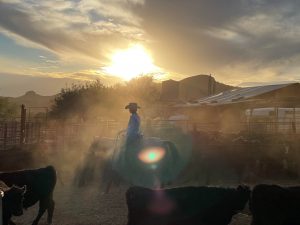Women in agriculture overall saw a slight decline in representation within the farming and ranching industries, according to the 2022 Census of Agriculture published this week by the U.S. Department of Agriculture’s National Agricultural Statistics Service. In 2017, the number of female producers totaled 1,227,461 (38 percent of the industry); for the 2022 data, there were 1,224,726 (36 percent). In comparison, there were 2,149,318 male producers as of 2022.
The majority of female producers, roughly 800,000, reported having “other” primary occupations outside of production agriculture. This is down from the 2017 numbers, and the amount of women who are in production agriculture full time have grown. The report reveals that about 490,000 women spent no days working off the farm, while there were 470,000 who spent 200 days or more working off the farm.
Beef cattle ranching, and crop farming make up the top two spots, respectively, for commodities farmed. The interesting fact is that beef cattle ranching has dropped by about 38,000 since 2017. In fact, many industries were lower in the 2022 census versus 2017. The crop farming, poultry and egg production, and greenhouse, floriculture and nursery categories had the most growth over the past five years.

Overall, farms that females own has dropped, but not substantially. Women who owned 1- to 9-acre farms dropped more drastically between 2017 and 2022 than every other farm size, most of which stayed almost the same, albeit a slight drop. About 800,000 women have operated their farms for 11 years or more.
The largest age group of female producers is 55 to 64 years, followed closely by 65 to 74. It seems that the 45 to 54 years age group has dropped off sharply since 2017, from 233,000 down to 192,400 in 2022. Only 19,500 are younger than 25. The average age was 57.8; it was 57.1 in 2017.
Every category of on-farm involvement in decision-making dropped from 2017, but a majority of women play a role in day-to-day decisions, with 960,000 reporting being decision-makers in 2022. Second to that is the record-keeping and/or financial management category, with 870,000 women. Thirdly, 717,000 women got to make land use and/or crop decisions in 2022.
Still, female producers were most involved in day-to-day record-keeping and financial management decisions when compared to male producers, who had higher rates of involvement in land use and/or crop, livestock and marketing decisions than female producers.
The state with the most female producers, by far, was Texas, with over 143,000 total, but even that was down from over 156,000 five years ago. The next state, coming in at 53,000, was Missouri. Iowa, Oklahoma, and Ohio round out the top five.
With a decline in farmland and farmers across the census, it’s no surprise that the number of females involved has decreased slightly. Still, female farmers remain an intricate piece to the success of the farming industry and a demographic integral to keeping farming progressing. As record-keepers and financial decision-makers, females may very well become deeply involved in securing some of the additional revenue streams that Secretary of Agriculture Tom Vilsack pointed to during a news conference on Tuesday.
“This survey, in addition to all of the amazing work and date it contains, is a wake-up call,” said Vilsack. “This survey is essentially telling us, asking the critical question of whether as a country, are we okay with losing that many farms? Are we okay with losing that much farmland? Or, is there a better way?”
Markie Hageman Jones majored in agribusiness at Fort Hays State University. She is actively involved in her state Cattlemen’s Association, Young Farmers chapter, and National Cattlemen’s Beef Association. Her AGDAILY.com articles can be found here.



